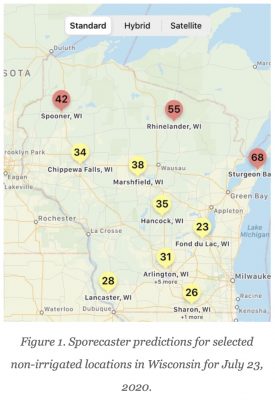Damon Smith, Extension Field Crops Pathologist, Department of Plant Pathology, University of Wisconsin-Madison
Damon Smith has posted a new item, ‘Wisconsin Soybean White Mold Update – July 23, 2020‘
The article shows the calculated risk of white mold for select Wisconsin locations for non-irrigated soybeans, as determined by Sporecaster for July 23, 2020. This means that if soybeans are flowering and the area between rows is filled in more than 50%, risk is just moderate in most locations of the state, with the exception of the far northern portions of the state and Door County, for the presence of apothecia and subsequent white mold development.

You may view the latest post at
https://badgercropdoc.com/2020/07/23/wisconsin-soybean-white-mold-update-july-23-2020/
Timing in-season fungicide sprays at the correct time during the soybean bloom period can be extremely difficult. To help solve this decision-making issue, models were developed at the University of Wisconsin-Madison in conjunction with Michigan State University and Iowa State University to identify at-risk regions which have been experiencing weather favorable for the development of white mold apothecia. These models predict when apothecia will be present in the field using combinations of 30-day averages of maximum temperature, relative humidity, and wind speed. Using virtually available weather data, predictions can be made in most soybean growing regions. To facilitate precise predictions and make the model user-friendly, we use Sporecaster smartphone application for Android and iPhone.